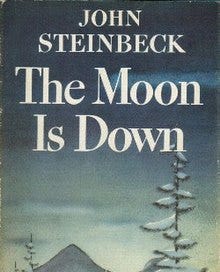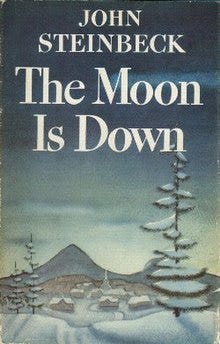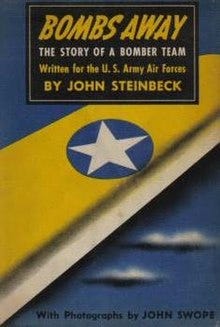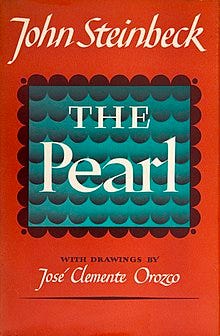The Steinbeck Review #5 - War and Nostalgia
The Moon is Down | Bombs Away | Cannery Row | The Pearl
Welcome to Beyond the Bookshelf, a community of readers and writers exploring the intricate relationships between life and literature and the profound narratives that bind them together.
In the years following the publication of The Grapes of Wrath, Steinbeck’s life became more complex. By this point, he struggled to accept the wealth and fame that were an inevitable part of his world. His marriage to Carol was on its last legs, and war was in everyone’s minds. Steinbeck believed he had purged himself of all good writing by pouring his soul into The Grapes of Wrath. In an attempt to recapture his purpose, he volunteered for the war effort. The focus of his writing changed, and many critics have proclaimed he never again found a central theme in his writing. These four short works show that he was searching for something to latch on to.
“I am a little man and this is a little town, but there must be a spark in little men that can burst into flame.”
The Moon is Down was published in 1942 by Viking Press. For years, Steinbeck had presented ideas to President Roosevelt to assist in the war effort, but it was not until he joined the Office of War Information that he could put his ideas into action. Serving as a correspondent in Europe, he utilized his observations on the war front to develop ideas into fiction and nonfiction works. This short work of civil resistance in the face of the enemy was one such effort.
Before World War II, Steinbeck had already established himself as a champion of the common person’s rights, focusing on domestic issues like worker’s rights and the Great Depression. However, with The Moon is Down, he turned his attention to the global stage, highlighting the universal themes of human rights and the struggle for freedom. These themes, still relevant today, are a testament to the timeless power of Steinbeck's writing.
The Moon is Down is a fictional account of a military occupation of a small town in Northern Europe. None of the locations are named, but the inferences are thinly veiled - this is the German occupation of Norway. The small town was invaded and overrun by surprise due to the strategic importance of its port and coal mine. The occupying forces attempt to maintain order through rigid discipline and forcing the citizens to work. Through a series of events, the citizens resist the occupation and fight back.
Steinbeck’s focus here is not just the horror and futility of war but also the resilience and courage of the human spirit. In telling the story of this small town, he brings to life the enduring strength of freedom that remains in the heart of an oppressed people. While he vividly portrays the damage done to the citizens of the town, those who have been deprived of their liberty, Steinbeck also takes the opportunity to describe the destructive and dehumanizing consequences of the occupying force, evoking a sense of empathy and understanding in the readers.
As resistance increases, the toll on the soldiers becomes obvious. Most of these are young men forced into service who believe their leaders misled them. Their only desire is to return home to their families. Steinbeck’s message here is unmistakable - no one wins in war.
The Moon is Down was later adapted for the stage, and the Norwegian royal family awarded Steinbeck the King Haakon VII Freedom Cross.
This is not your typical Steinbeck book. This little-known nonfiction account of a bomber crew was written and published in 1942. The US Army Air Forces hired Steinbeck to write this book to help recruit men to serve on bomber crews during World War II. Its unique perspective and Steinbeck's masterful storytelling make it a must-read for those interested in World War II and aviation history or are Steinbeck completists like myself.
Steinbeck traveled widely with photographer John Swope for 30 days to visit and interview bomber crews at various bases. The book explores the roles of the six members of the bomber crew: the pilot, navigator, bombardier, crew chief, gunner, and radio man. Each member is vital to the mission’s success and must work together to be successful.
Perhaps the least well-known and one of the few Steinbeck works out of print, Bombs Away still had its fans among critics. Robert Morsberger wrote, “Though written on assignment and under pressure, Bombs Away is by no means a piece of hackwork journalism….In particular, it is the most elaborate treatment of Steinbeck’s so-called phalanx theory, his interest in what happens when people work together as a group.”1
“Doc would listen to any kind of nonsense and turn it into wisdom. His mind had no horizon and his sympathy had no warp. He could talk to children, telling them very profound things so that they understood. He lived in a world of wonders, of excitement. He was concupiscent as a rabbit and gentle as hell. Everyone who knew him was indebted to him. And everyone who thought of him thought next, 'I really must do something nice for Doc.’”
When Cannery Row was published in 1945, Steinbeck’s personal life was a mess. He had recently returned from Europe, where he had written as a war correspondent. His second marriage was struggling, barely three years into it. His fame and wealth isolated him from the people he cared about. In a period of nostalgia, he wrote this work to recapture the feelings and people of his favorite years, those spent in Monterey. This personal context adds depth and resonance to the work, making it a compelling read for those interested in Steinbeck's life and creative process.
The story is set during the Great Depression along a street lined with sardine canneries and filled with characters from Steinbeck’s memory. Everything in this story revolves around the character Doc, based on Steinbeck’s good friend Ed Ricketts. The plot is relatively basic - a group of bums want to throw a party for Doc but their plans go awry so they try to make it up to him with a second party. Along the way there are a few side adventures. The characters are simple and so are their desires. There is a sense of fatalism throughout - the bums accept their lot in life and yet retain an innate optimism about the future.
While writing nostalgically, Steinbeck also used Cannery Row to expound on his moral ethos. He believed that actions are more powerful than words, which is never more evident than when Doc’s treatment of the downtrodden exemplifies kindness and altruism. In glorifying the simple life of the bums, Steinbeck also expressed his frustration with wealth and fame, both of which he felt were a chain around his neck.
Cannery Row has found a devoted following in popular culture and has been adapted for the stage and film. It is a simple and poignant tale that will pull at the heartstrings of most readers.
“For it is said that humans are never satisfied, that you give them one thing and they want something more. And this is said in disparagement, whereas it is one of the greatest talents the species has and one that has made it superior to animals that are satisfied with what they have.”
This beautiful novella, published in 1947, is based on a Mexican folk tale Steinbeck heard while traveling in Baja California. It is a short and easy read, which has led to its widespread use in school classrooms. Focusing on greed, family, and the oppression of indigenous peoples, this is a story of how fate and agency shape our lives.
The tale revolves around Kino, his wife Juana, and their son Coyotito. Throughout these events, Kino discovers a giant pearl that can change his family’s fortune. However, as the family soon learns, an influx of sudden wealth is not always the best thing. Neighbors, family, and the wealthy oppressors in the region all covet the pearl and attempt to acquire it through guile or direct action.
As Kino and Juana struggle to discern the best course of action for their small family, we can observe some of Steinbeck’s critical themes including:
man versus nature
man versus man
man versus himself
In the end, the ultimate question they must face is whether to allow fate to control their lives or if they will exert their independent will to determine the outcome of events.
This quick, thought-provoking read is highly recommended for readers of all levels.
I would love to hear from you in the comments. Have you read anything by Steinbeck? What was your impression? Any favorites?
Until next month…
Writing Beyond the Bookshelf is a labor of love and will continue to be free for all readers for the foreseeable future. If you want to support my writing financially and have the means, a couple of options are available. Buy Me a Coffee is a one-time “tip” as a way to say thank you. Subscribing at one of the paid tiers is for those who wish to provide ongoing support. Regardless of how you support my work, as a free subscriber or paid, I am grateful that you have chosen to be a member of this community of readers and writers exploring beyond the bookshelf as we discover the connections between life, literature, and stories.
John Steinbeck: A Biography by Jay Parini, 1995











Cannery Row is one of the books I read with colour pencils…. To study the sheer beauty, the simplicity yet extraordinarily masterful use of language. I want to understand how and why he uses the verb forms he does- why does he use simple past rather than continuous as an example? What subtle rhythm does he provoke? I once read the whole book looking for adverbs to understand how he describes emotion and in the scene when Doc finds the body, which is so very powerful, there is only one adverb (from memory). I haven’t delved into or persevered with any of his other works but Cannery Row is a masterpiece of literature and a treasure of literary craft.
Thanks for this. Haven’t read Steinbeck since school NIW i want to read cannery row.